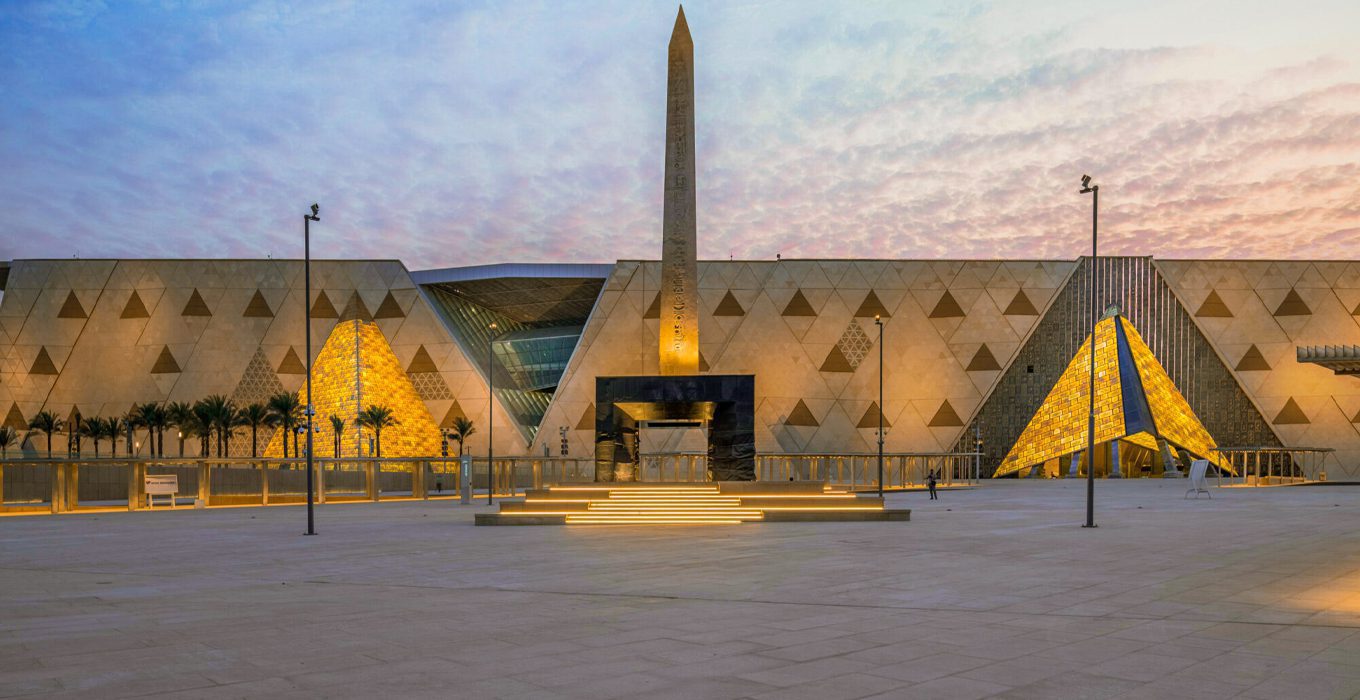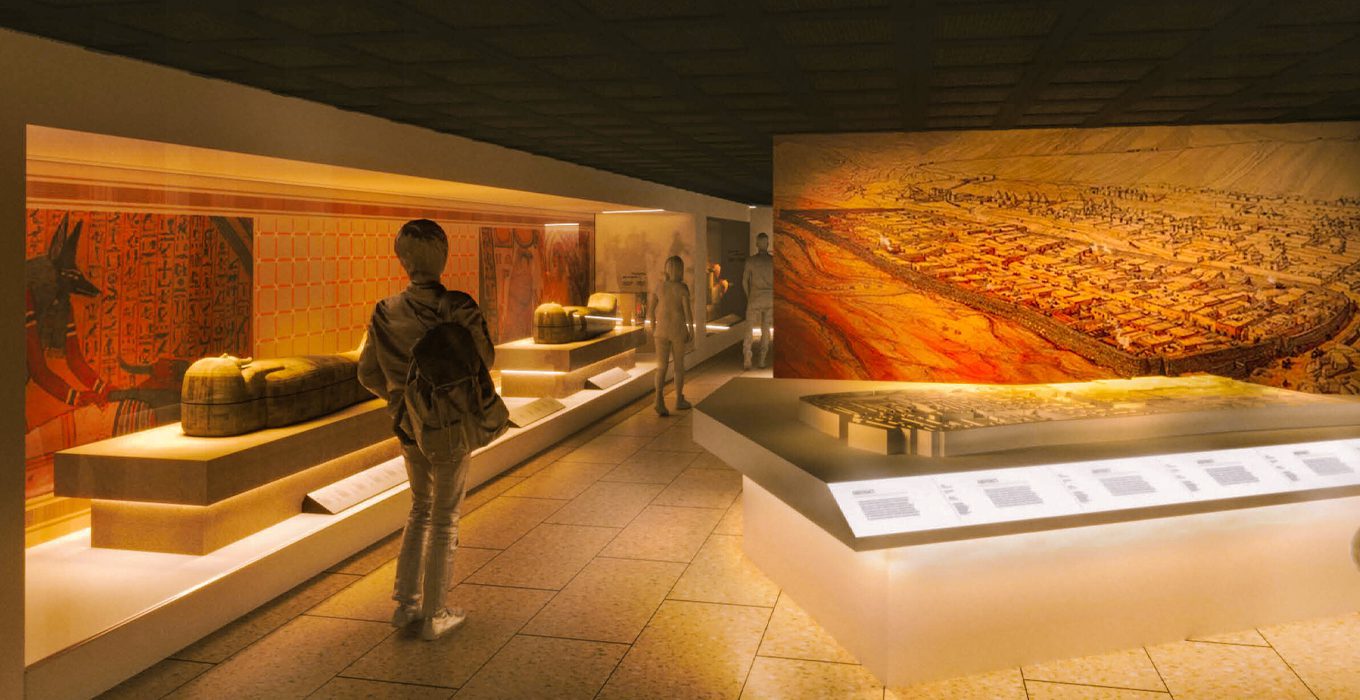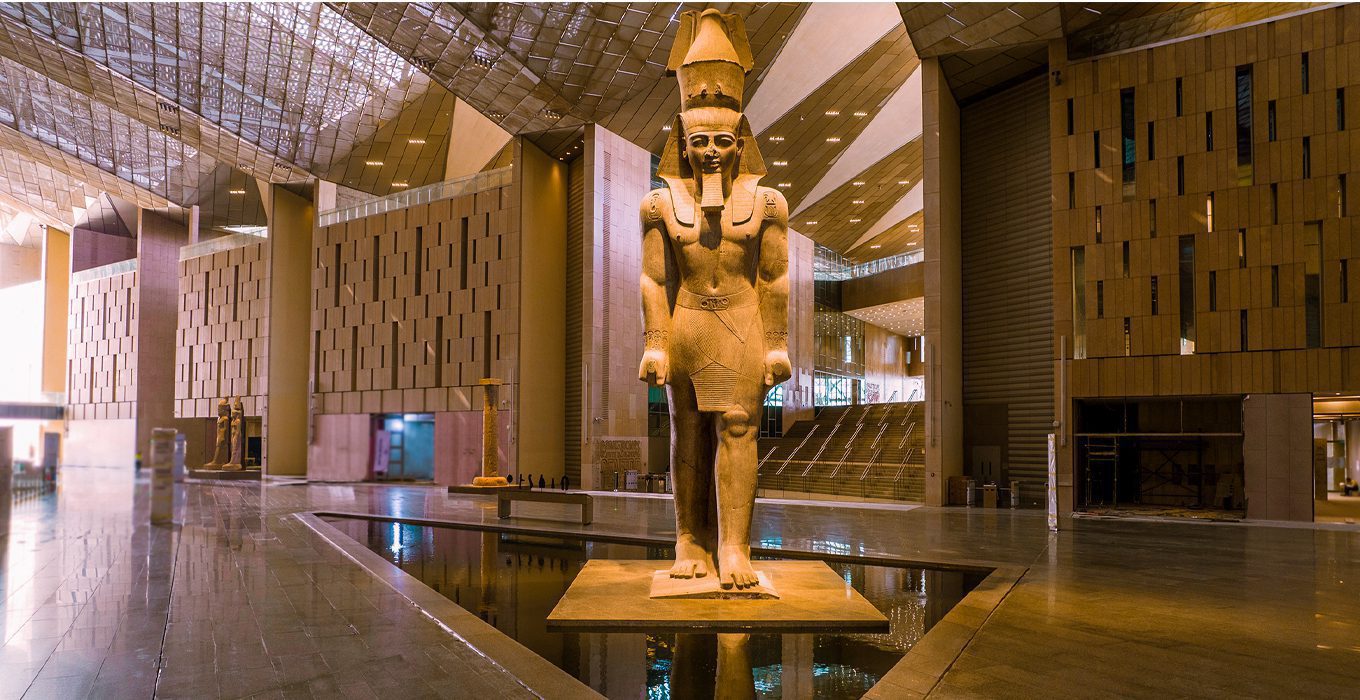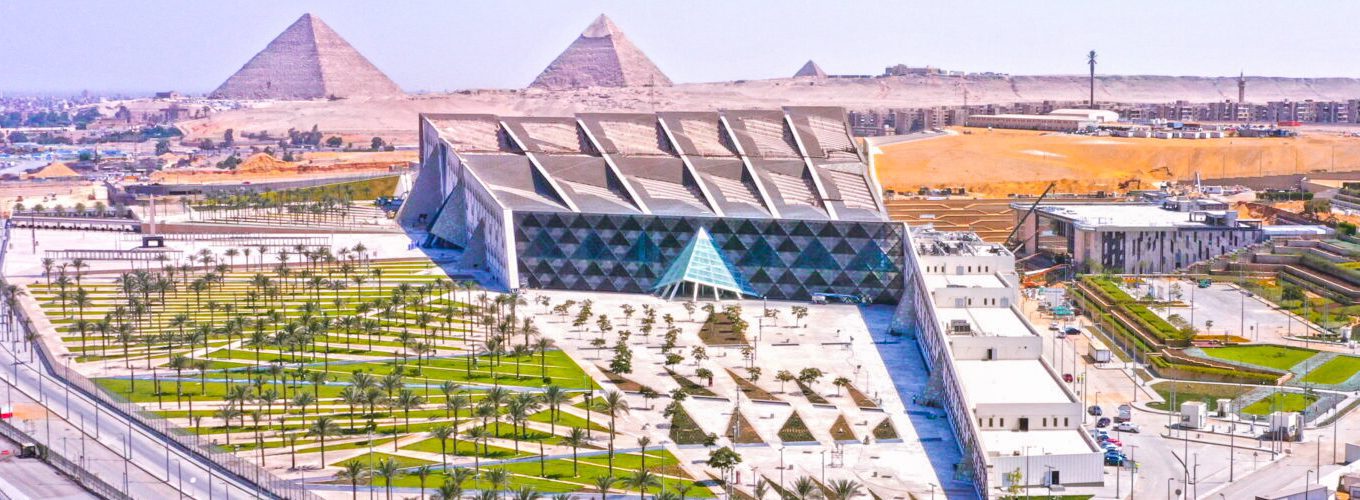Are you ready for an amazing journey through ancient Egyptian history? The Grand Egyptian Museum (GEM) in Egypt is in the top spot. It showcases the treasures of King Tutankhamun and rare pharaonic relics. This museum is the biggest archaeological museum in the world, and it lets you dive deep into the culture of this amazing land.
Book Your Tour Now!
Key Takeaways
- The GEM is set to be the largest archaeological museum in the world, housing an unparalleled collection of artifacts from the Nile Valley.
- The museum boasts the world’s first hanging obelisk, giving visitors a distinct perspective of ancient artifacts.
- The presence of 10 statues of Senusret I highlights the rich collection of ancient artworks available for viewing.
- The Grand Staircase showcases a curated collection of 64 monumental treasures from Egypt’s illustrious past.
- The museum’s Commercial Boulevard and extended hours (9:00 AM to 6:00 PM) suggest a thriving visitor-centric space.
Unveiling the Grand Egyptian Museum’s Treasures
Get ready to be amazed by the amazing ancient Egyptian artifacts at the Grand Egyptian Museum (GEM) in Giza. This modern museum will show the art, engineering, and culture of the pharaohs. It gives visitors a unique look into the rich history of the Nile Valley.
From Pharaonic Relics to Cultural Marvels
The museum has amazing displays with some of Egypt’s most important archaeological finds. You’ll see the famous treasures of King Tutankhamun. Rare statues, sarcophagi, and other relics will show the greatness of ancient Egyptian history.
|
Artifact Transfer |
Year |
|
Tutankhamun’s Treasures |
2017 |
|
Colossal Granite Statue of Ramses II |
2018 |
|
Khufu’s Solar Boat |
2021 |
The GEM has over 100,000 artifacts, making it the biggest museum for ancient Egyptian history. Visitors will be taken on a journey through time with the museum’s interactive exhibits. These exhibits will show the long history of pharaonic times.
“The Grand Egyptian Museum will explore around 3,000 years of ancient Egyptian history through its unparalleled collection of artifacts.”
If you love the mysterious Tutankhamun, the huge statues of pharaohs, or the ancient Egyptian technology, the GEM is for you. It offers a memorable trip through the long history of the Nile Valley.

Exploring the GEM Museum’s Unparalleled Collection
Step into the Grand Egyptian Museum (GEM) and get ready for an amazing journey. You’ll see ancient Egyptian artifacts that many have never seen before. The museum shows the long history of the Egyptian civilization through its vast collection.
The GEM is huge, as big as nine football fields, with 500,000 square feet of space. It holds almost 100,000 artifacts, including many that are public premieres. You’ll see everything from huge statues to detailed jewelry and old papyri.
|
Highlights of the GEM Collection |
Quantity |
|
Royal Mummies |
Over 20 |
|
Tutankhamun’s Treasures |
Almost 5,000 pieces |
|
Exhibition Halls |
12 |
|
Restoration Labs |
19 |
At the GEM, you’ll get an immersive cultural experience. There are interactive exhibits and tours with Egyptologists. You can also see how they preserve pharaonic treasures in the labs. The GEM shows the lasting impact of the archaeological wonders of Egypt.
You can benefit from our discounted offers through the following All Inclusive Vacations to Egypt:
- 7-Day Cairo with Nile Cruise Tour Package Get -100 USD
- 8 Days Cairo with 3 Nights Nile Cruise by Flight Get 10% Off + Free Activities
- 8 Days Cairo and Nile Cruise Holidays with Abu Simbel Get 7% OFF
- 10-Day Cairo, Alexandria, and Nile Cruise with Abu Simbel by Flight Get 10% OFF
- 12 Day Cairo City & Nile Cruise and Hurghada City
GEM Museum Egypt: A Gateway to Egypt’s Rich Heritage
The Grand Egyptian Museum, or the GEM, is a key place to see Egypt’s rich culture. When you walk in, you start a journey back in time. You feel like you’re part of ancient Egyptian life.
Immerse Yourself in the Grandeur of Ancient Egyptian Civilization
The museum has many artifacts that show us the lives of pharaohs and their people. You’ll see King Tutankhamun’s treasures and the mysterious Nefertiti bust. The GEM lets you dive into the magic of the Nile Valley and learn about ancient culture.
Walking through the museum, you’ll see huge and important exhibits. The Giza pyramids and the Valley of the Kings come to life with interactive displays. It feels like you’re right there in the past.
The GEM works hard to keep Egypt’s culture alive. It has special labs and centers for fixing artifacts. This way, these treasures will be here for people to see for a long time.
“The GEM Museum Egypt is a gateway to the heart of ancient Egyptian civilization, allowing visitors to immerse themselves in the grandeur and mystery of this captivating culture.”
If you love history, archaeology, or just the ancient world, the GEM Museum Egypt is perfect for you. It’s a chance to explore and enjoy Egypt’s past. Come and join the story that has amazed people for thousands of years.
The Grand Staircase: An Architectural Marvel
The Grand Egyptian Museum (GEM) has a grand staircase that is truly amazing. It’s an architectural wonder that welcomes visitors. As you go up the stairs, you see 64 huge pharaonic treasures. These include statues, obelisks, and other items that take you back to ancient Egyptian times.
Ascending into the Realm of Pharaohs
The grand staircase is a stunning start to the museum’s vast collection. It gets visitors ready for the amazing sights ahead. Towering above the entryway, the grand staircase shows the greatness of ancient Egyptian history. It invites guests to see the museum’s amazing collection of pharaonic artifacts.
The staircase is not just for going up and down. It’s a work of art that makes the museum’s cultural experience unforgettable. As you climb, you feel like you’re stepping into ancient Egypt. You’re surrounded by the beauty of pharaonic treasures.
“The grand staircase is a breathtaking introduction to the museum’s vast collection, transporting visitors into the realm of ancient Egyptian kings.”
The GEM’s grand staircase is made to amaze and inspire. It gives a sneak peek into the museum’s pharaonic artifacts and ancient Egyptian history. As you go up the stairs, you start a journey through the architectural marvel that is the Grand Egyptian Museum.
King Tutankhamun’s Exhibit: A Highlight of the GEM
The Grand Egyptian Museum (GEM) in Cairo has a special exhibit on King Tutankhamun. This young pharaoh ruled around 1333 BCE. His story has captured the world’s heart, and the GEM’s collection is unmatched.
At the museum, you can see the biggest collection of artifacts from Tutankhamun’s tomb. Howard Carter found them in 1922. You’ll see a replica of the king’s burial chamber. It shows the grandeur and importance of his legacy.
- The Tutankhamun Gallery at the GEM spans an impressive 7,500 square meters, housing over 5,400 artifacts, with approximately 3,000 never-before-seen objects.
- The exhibition reflects the life and reign of Tutankhamun, who ascended to the throne at the young age of 9 and ruled until around 19 years old.
- Visitors can expect to be captivated by the exquisite craftsmanship and cultural significance of Tutankhamun’s possessions, including his mummy, funerary mask, inner gold sarcophagus, jewels, and throne.
The Tutankhamun exhibit at the GEM is a must-see for anyone interested in Egyptian history and the “Boy King.” It takes you back in time. You’ll gain a deep understanding of this key period in Cairo museum exhibits and the tutankhamun collection that still fascinates us all.
Exclusive Behind-the-Scenes Tour of Conservation Labs
Step into the world of preserving artifacts at the Grand Egyptian Museum (GEM). You’ll see how experts keep Egypt’s treasures safe. This special tour lets you see the hard work behind saving pharaonic artifacts and cultural treasures.
On this half-day tour, you’ll watch how they fix and keep ancient Egyptian items safe. You’ll see how much care goes into saving things like papyri and statues. It’s amazing to see how they keep these important items safe for the future.
|
Tour Details |
Prices |
|
Duration: Half Day |
$1150 per person (Group of 9-17 adults) |
|
Available Days: All Days |
$1150 per person (Group of 5-8 adults) |
|
Children Policy: |
$1200 per person (Group of 3-4 adults) |
|
– 0-4 years: Free of Charge |
$1200 per person (2 adults) |
|
– 5-11 years: 50% of tour price |
$1250 per person (Solo traveler) |
|
– 12+ years: Full tour price |
Book your spot on this exclusive Egyptian antiquities tour with just a 10% down payment. See the beauty of Cairo and the Giza plateau during your visit to this amazing museum.

Plan Your Visit to the GEM Museum Egypt
Visiting the Grand Egyptian Museum (GEM) in Egypt is a unique chance to explore ancient Egyptian culture. It’s easy to plan your trip. With a few steps, you can make sure your visit is both enriching and memorable.
To get into the GEM, you can book your tickets online on the museum’s website or other ticket sites. You can pick your visit date, time, and even the language for your tour. The museum has many tours, like the Tutankhamun exhibit and the Grand Staircase, to match your interests.
If you have questions or need help, call the museum’s tourism info line at +20235317344 or email them at [email protected]. The staff is ready to help you plan your visit to the GEM Museum Egypt.
The museum is in a great spot and offers a lot to see. You’ll have an unforgettable time learning about ancient Egyptian culture and history. Don’t miss the chance to plan your visit to the GEM Museum Egypt and see its amazing exhibits.
Embrace Egypt’s Wonders with Egypt Planners’ Nile Cruises
Discover Egypt’s ancient beauty with a Nile cruise by Egypt Planners. Our luxury river cruises let you dive into the timeless charm of the Nile Valley. You’ll visit iconic spots that will amaze you.
See the huge Giza Pyramids and the mysterious Valley of the Kings in Luxor. Also, visit the peaceful temples of Aswan. Our Egypt travel packages show you Egypt’s rich history. Our guides will make these sites come alive for you.
Enjoy the luxury of luxury nile river cruises as you sail the legendary Nile. See beautiful landscapes and charming villages by the river. Enjoy delicious food, relax in luxury, and soak in the magic of this trip.
|
Tour Package |
Duration |
Highlights |
|
4-day Cairo & Alexandria Tour |
4 days |
Cairo, Giza Pyramids, Alexandria |
|
4-day Cairo & Luxor Tour |
4 days |
Cairo, Luxor, Valley of the Kings |
|
6-day Cairo & Nile Cruise |
6 days |
Cairo, Nile Cruise, Aswan, Kom Ombo |
|
7-day Cairo & Nile Cruise |
7 days |
Cairo, Nile Cruise, Luxor, Aswan |
|
8-day Cairo, Alexandria & Nile Cruise |
8 days |
Cairo, Alexandria, Nile Cruise |
|
8-day Cairo, Luxor, Aswan & Abu Simbel |
8 days |
Cairo, Luxor, Aswan, Abu Simbel |
|
9-day Cairo, Alexandria & Nile Cruise |
9 days |
Cairo, Alexandria, Nile Cruise |
|
10-day Cairo, Nile Cruise & Alexandria |
10 days |
Cairo, Nile Cruise, Alexandria |
|
Pharaohs Adventure 10 Days |
10 days |
Cairo, Nile Cruise, Luxor, Aswan |
|
12-day Cairo, Alexandria & Nile Cruise |
12 days |
Cairo, Alexandria, Nile Cruise |
Start an amazing journey through Egypt’s past and present with Egypt Planners’ Nile cruises. Contact us now to plan your dream egypt planners nile cruises. Discover the magic of this enchanting place.

Nearby Attractions: Giza Pyramids and More
The Grand Egyptian Museum (GEM) in Egypt is a top museum near famous sites. Near it, you’ll find the Giza Pyramids, the Sphinx, and Saqqara. These places show the ancient pharaonic civilization.
The Giza Pyramids are a UNESCO site and show ancient Egypt’s skill. The Great Pyramid, the biggest one, is the only ancient wonder left. The Sphinx is another must-see, making you think about ancient mysteries.
Saqqara is a big site that shows how ancient Egyptians buried their dead. It has the Step Pyramid and many tombs and temples. It’s a deep dive into Egyptian civilization highlights.
Visiting the GEM and these cairo attractions together lets you dive into Egypt’s culture and mystery. It makes your trip to Egypt even better.
Enhancing Your Egyptian Adventure
Make your Egypt trip great by seeing the giza pyramids exhibition and other spots near the GEM Museum. This will let you learn more about Egypt’s history and traditions.
- See the Giza Sound and Light Show, a show that lights up the Pyramids at night.
- Check out the Giza Plateau, a UNESCO site with the Great Pyramid, the Sphinx, and more.
- Go to the Abdeen Palace Museum in Cairo to see how Egyptian rulers lived.
- Visit the Imhotep Museum in Saqqara to learn about ancient Egyptian architecture and culture.
Exploring around the GEM lets you really get into the heart of Egyptian civilization highlights. It makes your trip unforgettable.
Shopping and Dining at the GEM Museum
The Grand Egyptian Museum (GEM) offers a full cultural experience. You can shop and dine in a special area. There are shops with Egyptian crafts, souvenirs, and artwork. It’s a great way to take a piece of Egypt home.
The museum also has many places to eat. You can find everything from casual cafes to fancy restaurants. The commercial boulevard at the GEM Museum has food for every taste.
|
Dining Options at the GEM Museum |
Cuisine |
Average Meal Price |
|
Zooba |
Egyptian Street Food |
$10-$15 |
|
30North |
Contemporary Egyptian |
$20-$35 |
|
Starbucks |
Coffee and Light Bites |
$5-$10 |
|
Beanos Coffee |
Specialty Coffee and Pastries |
$7-$12 |
Looking for a quick snack, a fancy meal, or a drink? The GEM Museum’s commercial boulevard has it all. Enjoy the rich culture of Egypt while you shop and dine.
Conclusion: An Unforgettable Journey Through Time
A trip to the Grand Egyptian Museum (GEM) in Egypt is an unforgettable adventure. It takes you through the vast history of ancient Egyptian civilization. You’ll see the treasures of King Tutankhamun and the museum’s stunning design.
Adding a luxury Nile cruise and visiting nearby archaeological sites like the Giza Pyramids makes the trip even better. This lets you fully experience Egypt’s cultural heritage. The museum has over 100,000 ancient Egyptian artifacts in a huge complex.
Whether you choose a private tour for special access or explore on your own, the GEM will amaze you. Knowledgeable guides make each visit a journey through time. The Grand Egyptian Museum shows Egypt’s lasting cultural importance. It gives visitors a deep and meaningful experience that goes beyond time.
Related Articales

